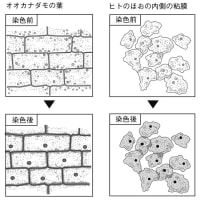
私が中学生のときには、顕微鏡も反射鏡で光を集めて明るさを調整したものだが、今では光源にLEDランプが使われているらしい。
LEDランプは発光時の熱発生が抑えられており、観察物を加熱する心配が少ない。
また、反射鏡で光の方向を調整する必要がないため、実験の時間を短縮できる。
反射鏡で光を集めるだけでもかなりの時間が必要なものだった。
便利な世の中になった。
When I was a student of JHS we used microscopes with mirrors to focus sunlight, but now the students can use LEDs instead of sunlight.
LEDs generate less heat when emitting light so that we can observe objects without the risk of heating.
In addition, we don't have to adjust the direction of light with a mirror, we can reduce the time of adjustment.
It used to take a lot of time just to collect light with a mirror.
The world has become a convenient place!
中1では水の中の生物の観察、
中2では植物や動物の細胞の観察、
中3では細胞分裂するようすの観察を行うので、全学年にわたって顕微鏡のスキルは必要である。
7th grade : observation of organisms in the water
8th grade : observation of cells of plants and animals
9th grade : observation of cell division
All level students need more skills of microscopes.


【顕微鏡の扱い方】
接眼レンズは埃が鏡筒に入ることを防ぐため、できるだけ外さない。
持ち運ぶときは、アームと土台を両手で支える。
【Treatment of microscopes】
We should not remove ocular lens to prevent entering the dust intotube and objective lenses.
When we carry our microscopes we have to support "arm" and "base" with our TWO hands.
【顕微鏡を使った観察の仕方】
① 視野を明るくする。
対物レンズを低倍率のものにして、しぼりと反射鏡を調整する。
② 対物レンズとプレパラートを近づける。
観察物が対物レンズの下(視野の中心)にくるようにプレパラートをステージにのせる。
横からのぞきながら対物レンズをできるだけプレパラートに近づける。
③ ピントを合わせる。
接眼レンズをのぞきながら調節ねじを回して対物レンズをプレパラートから離し、ピントを合わせる。
顕微鏡によっては、調節ねじに微調整ねじがついていることもある。
④ 高倍率にしてくわしく観察する。
レボルバーを回して対物レンズを高倍率のものに変え、くわしく観察する。
視野が暗く、狭くなるので、しぼりを調整して明るくする。
観察物が視野の中心にないときには、視野の中心と反対方向に引っ張るようにしてプレパラートを移動させる。
(顕微鏡の視野は上下左右が逆になっているため)
【How to observe with microscope】
① Brighten the field of view.
Use a lower magnification objective lens and adjust the condenser and mirror.
② Bring the objective lens and the preparation close together.
Place the preparation on the stage and we can observe the object under the objective lens (in the center of the field of view).
Bring the objective lens as close as possible to the preparation while looking through it from the side.
③ Adjust focus.
While looking through the ocular lens, turn the adjustment knob to move the objective lens away from the preparation and bring it into focus.
Some microscopes have a fine adjustment knob attached to the adjustment knob.
④ Observe with high magnification.
Change to high magnification objective lens while turning nose piece.
The field of view would be dark and narrow so that we have to adjust condenser and make the field of view brighter.
When the object under observation is not in the center of the field of view, move the preparation by pulling it in the direction opposite to the center of the field of view.
(Because the microscope's field of view is upside down.)
【拡大倍率の求め方】
接眼レンズの倍率 × 対物レンズの倍率
【How to calculate the magnification】
Magnification of ocular lens × magnification of objective lens
【プレパラートの作り方】
プレパラートとは、完成品のことである。
よく、スライドガラスのことをプレパラートという生徒がいるので、注意しよう。
① スライドガラスの上に(必要ならスポイトで水を一滴落とし、その上に)ピンセットで観察物を置く。
② 観察物の上に(必要なら)スポイトで水を一滴落とす。
観察の種類によっては、酢酸カーミン液などの染色液を使う。
③ 柄つき針で支えながらカバーガラスの端を水の端に合わせ、ピンセットで空気が入らないようにカバーガラスを下ろす。
はみ出た水などは小さく切ったろ紙で吸い取る。
このとき、水を吸い取りすぎないように気をつける。
【How to make the preparation】
"Preparation" is a finished product.
Some students often get it wrong that microscope slide is preparation.
① Put an object on the microscope slide with tweezers (if necessary, you may put a drop of water using pipette and put the object on the water).
② (If necessary) put a drop of water with a pipette on the object.
In the case of observation, we use stain such as carmine acetate.
③ While supporting it with a needle with a handle, align the edge of the cover glass with the edge of the water and lower the cover glass with tweezers to prevent air from entering.
Remove any overflowed water with a small piece of filter paper.
Be careful not to absorb too much water at this time.






















※コメント投稿者のブログIDはブログ作成者のみに通知されます